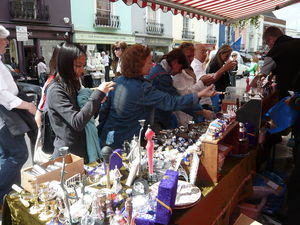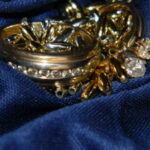The future of London’s famous Portobello Road Market as we have known it and loved it is at risk. No matter what one’s views may be on the expansion of popular chain stores into historic districts, there is no question that the authenticity of Portobello Road Market has been compromised already.
Portobello Road’s Timeline
In the heart of London’s Notting Hill within the Royal Borough of Kensington and Chelsea, Portobello Road has seen Saturday trading in fruit and vegetables since the mid-19th century. Following World War II, antique dealers came along, making Portobello the largest antique market in the whole of London. There were occasional handsome treasures and fun knick-knacks to be found, in my experience, straight through into the early ’90s.
Wonderful Stuff
If you were one of the 1 million visitors per year to Portobello Road’s Saturday market, you may have met the pearl button lady; admired antique swords; or engaged in lively conversation with traders over their Victorian ceramics and teacup collections, old fountain pens, beloved antique dolls and stuffed teddy bears, piles of linens and lace, historic maps and botanical prints, engraved hallmark silverware, pocket and wristwatches, old stamps, Roman coins and shiny brass telescopes, miniatures, military souvenirs, and more. As a resident, you might have gotten your morning croissant from Mr. Christian’s, your fish and chips at the hole in the wall, and dragged your Christmas trees home from the vendor by the alleyway. This was a vibrant neighborhood for locals on a first-name basis, for children who grew up together playing at the sandpit. We were also proud to be a weekly international attraction.
“Notting Hill,” The Movie
When we moved from across town to Notting Hill in the ’80s, it was fairly downtrodden, grand Victorian houses chopped up into bedsits and tiny flats. Squatters were common. A licensed black cab driver declined to drive me home on one occasion. A few years later, out running errands with kids in tow, it was certainly exciting to run into a debonair Hugh Grant and a black beret-wearing Julia Roberts filming a scene at the corner of Westbourne Park Road and Portobello Road. However, the success of that film resulted in tour buses rolling in as the character of the neighborhood underwent big changes. Still bigger changes continue. The Travel Bookstore, the inspiration for Hugh Grant’s character in the movie, has recently closed its doors.
Not Another High Street!
High Street is the name for a Main Street in the U.K., which has far too many of them looking quite alike, town after town throughout the nation. Save the Portobello Market is a non-profit organization dedicated to preserving the unique atmosphere of this market, which has nearly 40,000 friends on its Facebook page, myself included. Friends of Portobello is also urging borough officials to stem the tide of gentrification by resisting overzealous landlords.
Yesterday in W11
True enough, with the passage of time, some things will change. Scrap dealer Tommy, the rag and bones man with his cart and horse, Basil, will not be seen again. The home of Sally and Stanley, chatty parrots who lived at the corner of Kensington Park Road, has become a Paul Smith menswear boutique. The organ grinder and his monkey have disappeared. Gone are the butcher, the baker, the candlestick maker, and in their places are overpriced fashion chain stores and designer jewelery makers.








